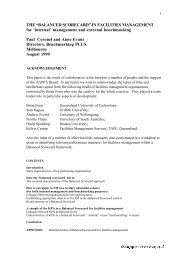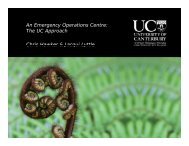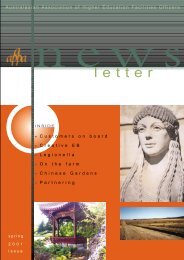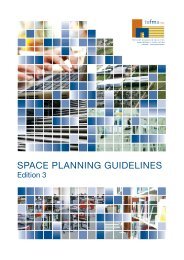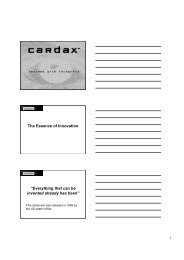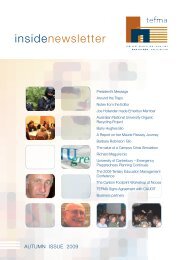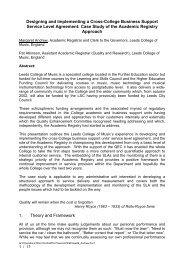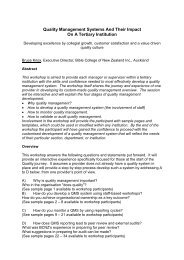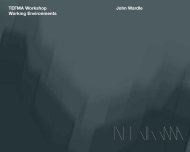insidenewsletter - Tertiary Education Facilities Management ...
insidenewsletter - Tertiary Education Facilities Management ...
insidenewsletter - Tertiary Education Facilities Management ...
You also want an ePaper? Increase the reach of your titles
YUMPU automatically turns print PDFs into web optimized ePapers that Google loves.
<strong>insidenewsletter</strong> AUTUMN/WINTER 2006 3<br />
learning about learning environments<br />
TEFMA/Zauner Construction Travel Scholarship 2005<br />
Diana Jones is a<br />
Senior Project<br />
Architect with Lyons<br />
Architects in<br />
Melbourne. In addition<br />
to her architectural<br />
practice, Diana tutors<br />
in architectural design at RMIT and for<br />
the Royal Australian Institute of<br />
Architects ‘Practice of Architecture<br />
Learning Series’.<br />
Diana studied at UWA in Perth before<br />
moving to Melbourne in 1995 where<br />
she has worked on a broad range of<br />
public and institutional facilities, including<br />
the National Museum of Australia<br />
with ARM. In 2002 she joined the<br />
enthusiastic team at Deakin University,<br />
to pursue an interest in campus<br />
master planning and the design of<br />
educational facilities. At the start of<br />
2006, she left Deakin to join the innovative<br />
and skilled team at Lyons.<br />
Current projects include the Hedley<br />
Bull Centre for World Politics at ANU.<br />
Diana was co-recipient of the TEFMA/<br />
Zauner Construction Travel Scholarship<br />
in 2005. A full report of her study tour<br />
is available on the TEFMA website,<br />
including photographs and information<br />
about many of the facilities visited:<br />
www.tefma.com/whatsnew<br />
The proposal<br />
When I started working in the<br />
Property Services Division at Deakin<br />
I was fortunate to be able to attend<br />
some TEFMA events, meeting other<br />
facility managers, and hearing about<br />
other campuses and facilities and<br />
aspects of their management and<br />
operation. Coming from a background<br />
in architectural practice it was<br />
a broad and steep learning curve,<br />
and I was keen to visit and experience<br />
different campuses and find<br />
out more. How are similar issues<br />
tackled, and what different hurdles<br />
do we face The TEFMA/Zauner<br />
Construction Travel Scholarship<br />
provided me with a fantastic<br />
opportunity to do this.<br />
In my position at Deakin I was<br />
involved in campus master planing,<br />
developing design standards, and<br />
briefing and preliminary design work<br />
for new projects. Like other universities,<br />
tightening budgets, the need to<br />
maximise space utilisation and<br />
efficiency, and increasing levels of<br />
discussion about how teaching was,<br />
would or could be delivered, were<br />
influencing capital works of all sizes.<br />
The topic for my scholarship, developed<br />
in consultation with my supervisor<br />
at Deakin, Mr Wayne Reid, was<br />
an area we were keen to learn more<br />
about, and which keyed into the<br />
theme for the TEFMA workshops<br />
conducted in 2005. It related to a<br />
book written by Lennie Scott Weber,<br />
published by SCUP, titled In Sync:<br />
Environmental Behaviour and the<br />
Design of Learning Space, and<br />
proposed to examine:<br />
• the types of learning environments<br />
we currently provide<br />
• what issues are driving the design<br />
of new or refurbished teaching<br />
spaces, and<br />
• how our customers are using<br />
these spaces.<br />
Through the study I identified a<br />
range of key issues for consideration<br />
in the design of new teaching and<br />
learning spaces – learning that I’m<br />
already applying to projects in my<br />
current role at Lyons.<br />
The study tour<br />
Under the scholarship I attend the<br />
TEFMA Future Learning Environments<br />
workshop in Brisbane in February<br />
2005, and also toured a number of<br />
universities in October and November<br />
2005. The facilities I visited were<br />
based on projects I’d read about or<br />
had been discussed in the Brisbane<br />
workshop, and focused on general<br />
teaching spaces, although some<br />
special purpose and laboratory spaces<br />
were visited. Full details are available in<br />
my tour report on the TEFMA website:<br />
www.tefma.com/PDFs/StudyTour<br />
Report_DianaJones.pdf<br />
The workshop enlightened to me<br />
the breadth of the issues and<br />
challenges to the creation of effective<br />
future learning spaces, and also<br />
demonstrated that there is a range of<br />
possible responses or approaches<br />
that can be taken.<br />
.<br />
UQ COLLABORATIVE SPACE<br />
THE CLASSROOM CAN BE BROKEN UP<br />
INTO SEPARATE ‘PODS’ FOR GROUP<br />
EXERCISES BY DROP-DOWN SCREENS<br />
AND SET LIGHTING LEVELS.




